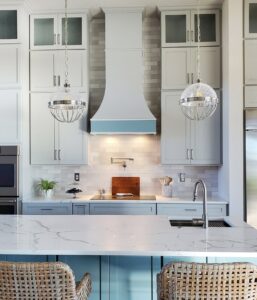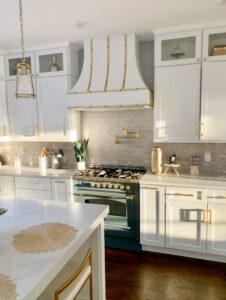One of the key features of the kitchen is the color. Color plays a significant role in the outlook of the kitchen. It gives life to the kitchen and makes staying in the kitchen more fun. Research also reveals that color can have a psychological impact on your mood and behavior at large. So, it is crucial to use the ideal kitchen hues.
Choosing the right color palette for the kitchen isn’t a task you can take for granted. There are several criteria to consider and steps to follow to arrive at a suitable color palette that not only beautifies your culinary space but also aligns with your psyche and desires.
We know you are curious to know the factors and steps to follow when selecting the appropriate color palette for your kitchen. Don’t worry! We’ll teach you how to choose the best kitchen shades in a moment.
1. Consider the Style of the Kitchen
You must take the style and layout of your kitchen into account if you want to choose a fitting color for it. The several kitchen styles—traditional, modern, farmhouse, industrial, and so on – have their characteristic accents. For instance, the combination of white and gray is a classic color palette that fits any style of kitchen. The black and white palette goes with a contemporary kitchen. Meanwhile, a white and wood palette is ideal for a farmhouse-style kitchen.
It is important to choose a kitchen palette that matches your kitchen style. Picking the wrong palette for a style can disrupt the kitchen color harmony.
2. Consider the Size of the Kitchen
The size of your kitchen is an important factor to consider during your kitchen color selection. Lighter colors can make a small kitchen appear spacious. Large spaces, on the other hand, afford you a wide range of color options.
3. Pick a Base Color
The base color is the primary color of your kitchen. This color is the most pronounced in the kitchen and covers most of the walls. When picking a base color, it is advisable to go for neutral colors such as white, beige, and gray. Any of these neutral colors will combine well with most other colors.
4. Select Accent Colors
Accent colors should complement the base color that you have chosen. You can stir visual interest in your palette by choosing contrasting colors as accent colors against the base color. For example, if the base color is gray, you can get dark-colored accessories.
5. Ensure Color Balance
Accent colors should be used in small doses so that they do not erode your base color. Ensure a balanced distribution of colors throughout the kitchen to keep a sense of cohesion. Repetition of the colors in different areas can also help with palette cohesion. Moreover, you should avoid too many bold or clashing colors.
6. Natural Light
The natural light that your kitchen receives is another determinant of the ideal kitchen hues for its interior. If the natural lighting is poor, it is advisable to go for lighter colors like white or yellow. This decision is about functionality, as lighter colors can brighten the space and enhance visibility.
7. Trending Palettes
Styles and trends change from time to time, and you want to be included. You can take insights from prevailing kitchen color trends and inspiration if you need more clarification as to what colors to go for. Check out the kitchen decor of your friends, neighbors, and relatives. Your observation could help you come up with great palette ideas for your kitchen.
8. Personal Preference
What are your favorite colors? Go for them when choosing your kitchen palette. After all, the interior decor of your kitchen should reflect your tastes and preferences. Your favorite color can serve as the base color from which you build your palette. Else, it can be one of the accent colors for the palette.
9. Future Preferences
Trendy color options may be appealing right now. Would you still like them in a few years? This consideration will help you avoid making a hasty decision when selecting a color palette for your kitchen.
10. Future Preferences
When setting up your kitchen, it is important to consider your pocket. Some color palettes will eat deep into your pocket, while others are budget-friendly. Therefore, choosing the right color palette ultimately hinges on your financial capability. You can go for an elaborate palette with a mixture of several complementary colors if you have the means. Alternatively, there are several simple yet colorful kitchen designs that you can consider if you’re on a budget.
Final Thoughts
Maintaining balance and color coordination in the kitchen may be a challenging task. Even with your best efforts, the result may not be satisfactory. If you’re still unsure, having considered the factors above and followed the tips in the article, then it’s better to engage the services of an expert.
A kitchen designer can provide kitchen color tips based on your specific requirements and kitchen attributes. The expert guidance by these professionals will help to uplift your kitchen and give it a befitting look.

